

HAPPY EASTER !
WESOŁYCH ŚWIĄT WIELKANOCNYCH !
JOYEUX PÂQUES !
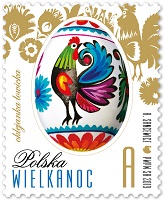
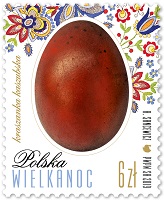
Wielkanoc
Easter
www.poczta-polska.pl
Wartości: A i 6 zł … autorka projektów znaczków: Agnieszka Sancewicz;
liczba znaczków: 2; nakład: A – 5 000 000 szt. i 6 zł – 1 000 000 szt.;
technika druku: rotograwiura; format znaczków: 25,5 x 31,25 mm;
papier: fluorescencyjny; arkusz sprzedażny: po 100 znaczków;
data wprowadzenia do obiegu: 18 marca 2019 r.

Easter … denomination: A (2,60 PLN); 6,00 PLN;
number of stamps : 2; printing technique: photogravure;
print run: millionth; stamp size: 25,5 x 31,25 mm;
circulation date: 18th March 2019; 100 stamps per sheet;
number of FDC: 1; author: Agnieszka Sancewicz.
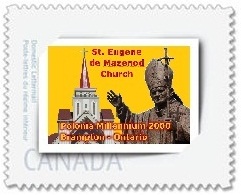
Papież św. Jan Paweł II / Pope St. John Paul II
1920 – 1978 – 2005
PROCLAIMED in CANADA – April 2nd is Pope St. John Paul II Day !!!

TROYAK EXECUTIVE TEAM is informing all members, colleagues, collectors and Polonia at large, that Club meetings taking place at John Paul II Polish Cultural Centre, 4300 Cawthra Rd. (just south of Hwy. 403), Mississauga, Ontario. The new members are always welcome. www.polishculturalcentre.ca
ADRES SPOTKAÑ KLUBOWYCH ! Zarząd Główny Klubu “Troyak” informuje wszystkich członków kolekcjonerów, sympatyków oraz całą Polonię, że spotkania klubowe odbywają się w Polskim Centrum Kultury im. Jana Pawła II, przy 4300 Cawthra Rd. (na południe od autostrady 403), Mississauga, Ontario. Zapraszamy nowych członków do prężnego. Klubu “Troyak”. www.polishculturalcentre.ca

“TROYAK” CLUB NEXT MEETINGS …
NASTĘPNE SPOTKANIA KLUBU “TROYAK” …
28th April 2019 @ 4:30 p.m.
26th May 2019; 23rd June 2019
July & August 2019 – Summer break … Letnie wakacje …
29th September 2019
6th October 2019 @ 9:00 a.m. to 4:00 p.m.
… Mississauga’s Coin & Stamp Show 2019
27th October 2019; 24th November 2019


100-lecie Ordynariatu Polowego
www.poczta-polska.pl
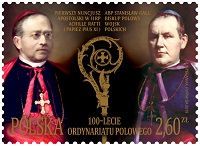
Wartość: 2,60 zł … autor projektu znaczka: Roch Stefaniak
liczba znaczków: 1; nakład: 150 000 szt.; technika druku: rotograwiura;
format znaczka: 43 x 31,25 mm; papier: fluorescencyjny;
arkusz sprzedażny: 50 znaczków;data wprowadzenia do obiegu: 5 lutego 2019 r.

100. rocznicy powstania PKO Banku Polskiego
www.poczta-polska.pl
Zarys warszawskiej Rotundy widnieje na okolicznościowym znaczku Poczty Polskiej upamiętniającym 100. rocznicę powstania PKO Banku Polskiego. Szkic warszawskiej Rotundy, najbardziej charakterystycznego budynku PKO Banku Polskiego i jednego z symboli stolicy, umieścił na znaczku Karol Tyczyński, autor projektu graficznego tej emisji. Na znaczku widnieje także logotyp banku, przygotowany specjalnie z okazji 100-lecia jego istnienia.
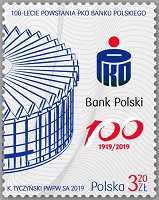
Znaczek o wartości 3,20 zł został wyemitowany w nakładzie 100 tys. sztuk. Trafił do obiegu 7 lutego 2019 r. dokładnie 100 lat po tym, jak naczelnik państwa Józef Piłsudski, premier Ignacy Paderewski oraz minister poczty i telegrafów Hubert Linde podpisali dekret o utworzeniu Pocztowej Kasy Oszczędności – poprzedniczki PKO Banku Polskiego. Misją Kasy było nie tylko zapewnienie Polakom usług bankowych, ale przede wszystkim zorganizowanie systemu gromadzenia oszczędności, niezbędnych do odbudowy kraju po latach zaborów i zniszczeniach pierwszej wojny światowej.
PKO Bank Polski oraz Pocztę Polską łączy stuletnia współpraca i historyczna zażyłość. To w placówkach pocztowych, w okresie międzywojennym, Polacy mogli wpłacać i odbierać wkłady z książeczek oszczędnościowych PKO czy zawierać ubezpieczenia na życie. PKO Bank Polski współpracuje z Pocztą Polską w wielu obszarach. Poczta obsługuje Bank m.in. w zakresie nadawania listów i przesyłek kurierskich, transportu i ochrony wartości pieniężnych. Średnio w miesiącu za jej pośrednictwem nadaje ok. 3,5 mln listów. Natomiast PKO Bank Polski prowadzi rachunki Poczty Polskiej. Wraz z nią jest akcjonariuszem Banku Pocztowego. Wspólnie ze spółką eService, umożliwia płatności kartą w sieci placówek Poczty Polskiej. „100-lecie powstania PKO Banku Polskiego” to nie pierwszy znaczek wyemitowany przez Pocztę Polską, którego tematem było PKO. W 1961 roku została wyemitowana seria pod hasłem „Październik miesiącem oszczędzania”. – Obie instytucje – Pocztę Polską i PKO Bank Polski łączy bardzo dużo. Każdego dnia, od wielu dziesięcioleci świadczymy usługi na rzecz naszych obywateli. Wprowadzając nową ofertę, chcemy spełniać ich oczekiwania. Poczta Polska ma największą w kraju sieć swoich placówek – jesteśmy w każdej gminie, zaś PKO Bank Polski jest największym bankiem detalicznym – mówi Przemysław Sypniewski, prezes zarządu Poczty Polskiej.
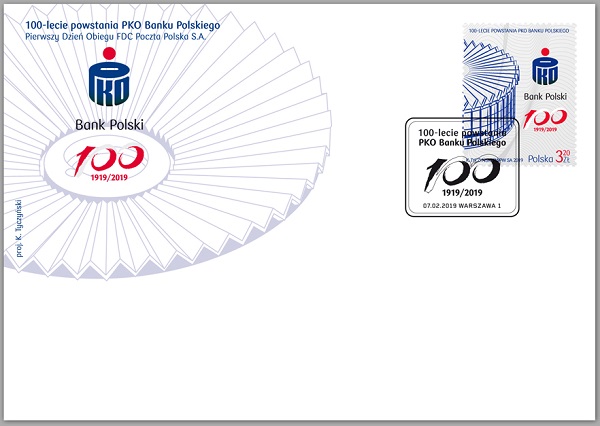
Na znaczku widnieje wizerunek Rotundy. Obiekt został wybudowany w 1966 roku. Położony u zbiegu ul. Marszałkowskiej i Al. Jerozolimskich budynek powstał, jako wzór nowoczesnego oddziału banku. Nowatorski projekt na rzucie okręgu, oszklony i z charakterystycznym dachem, był nazywany „czapką generalską”. Przez ponad 50 lat istnienia Rotunda wrosła trwale w życie miasta, stając się jednym z symboli stolicy i ulubionych miejsc spotkań mieszkańców i turystów.

100. rocznica utworzenia sieci Archiwów Państwowych
www.poczta-polska.pl

Wartość: 3,20 zł … autor projektu znaczka: Ryszard Kufel;
liczba znaczków: 1; nakład: 100 000 szt. papier: fluorescencyjny;
technika druku: rotograwiura; format znaczka: 31,25 x 43 mm;
arkusz sprzedażny: 50 znaczków; data wprowadzenia do obiegu: 7 lutego 2019 r.

100 lat Sejmu Ustawodawczego
www.poczta-polska.pl

Wartość: 5 zł … autor projektu znaczka: Jan Konarzewski;
autor portretu: Antoni Cygan; liczba znaczków: 1; nakład: 144 00 szt.
technika druku: offset; format znaczka: 31,25 x 39,5 mm;
papier: fluorescencyjny; arkusz sprzedażny: 12 znaczków;
data wprowadzenia do obiegu: 8 lutego 2019 r.
Poczta Polska uczciła 100. rocznicę Sejmu Ustawodawczego … Poczta Polska uroczyście zainaugurowała emisję nowego znaczka w gmachu Sejmu. Walor o wartości 5 zł został wydany z okazji 100. rocznicy rozpoczęcia obrad Sejmu Ustawodawczego. Do obiegu trafił 8 lutego br. Nowy znaczek okolicznościowy przedstawia wizerunek Wojciecha Trąmpczyńskiego, marszałka Sejmu Ustawodawczego oraz prawnika i działacza Narodowej Demokracji. Inauguracyjne posiedzenia jednoizbowego parlamentu 10 lutego 1919 roku otwierał Józef Piłsudski. Przemawiając do nowo wybranych posłów, podkreślił, że powołanie sejmu jest wielkim radosnym świętem narodu po długiej ciężkiej nocy cierpień. Ostatnie posiedzenie odbyło się zaś 27 listopada 1922 roku.
Do zadań Sejmu Ustawodawczego należało m.in. uchwalenie nowej konstytucji. Posłowie dokonali tego w ciągu zaledwie dwóch lat w warunkach ciągle toczących się walk o granice państwa i przy ogromnych problemach wewnętrznych. Nowa ustawa zasadnicza została przyjęta 17 marca 1921 r. Kadencja Sejmu Ustawodawczego zakończyła się w listopadzie 1922 r. wraz z wyborami parlamentarnymi. – Znaczki pocztowe to zdecydowanie coś więcej, niż tylko potwierdzenie zapłaty za usługi, jakie świadczy Poczta Polska. Te małe dzieła sztuki towarzyszą wydarzeniom ważnym dla naszego kraju. Upamiętniamy na nich najważniejszych polskich bohaterów i największe wydarzenia historyczne. W ubiegłym roku specjalną edycją filatelistyczną uczciliśmy jubileusz 550-lecia parlamentu na ziemiach polskich, który przypomniał nam wszystkim, że nasz parlamentaryzm ma wielowiekową tradycję. Teraz wspominamy Sejm Ustawodawczy, który odegrał niezwykle istotną rolę w XX-leciu międzywojennym – mówi Przemysław Sypniewski, prezes zarządu Poczty Polskiej.
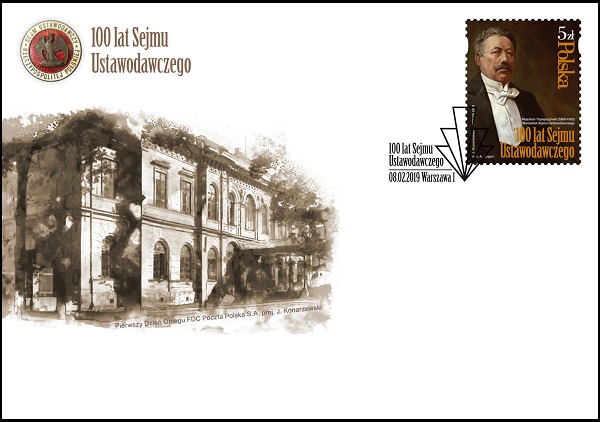
Uroczysta prezentacja znaczka odbyła się 21 lutego br. w gmachu Sejmu, zorganizowała ją Kancelaria Sejmu we współpracy z Pocztą Polską. Poczta Polska upamiętniła w ubiegłym roku m.in. 100. rocznicę odzyskania przez Polskę niepodległości. Na okolicznościowych znaczkach znalazły się wizerunki Ignacego Jana Paderewskiego, Józefa Piłsudskiego, Romana Dmowskiego, Wincentego Witosa, Ignacego Daszyńskiego, Wojciecha Korfantego.

100-lecie polskiej Służby Więziennej
www.poczta-polska.pl
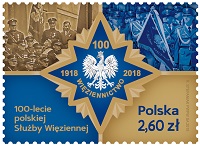
Wartość: 2,60 zł … autor projektu znaczka: Roch Stefaniak;
liczba znaczków: 1; nakład: 100 000 szt.; technika druku: rotograwiura;
format znaczka: 43 x 31,25 mm; papier: fluorescencyjny;
arkusz sprzedażny: 50 znaczków; data wprowadzenia do obiegu: 8 lutego 2019 r.
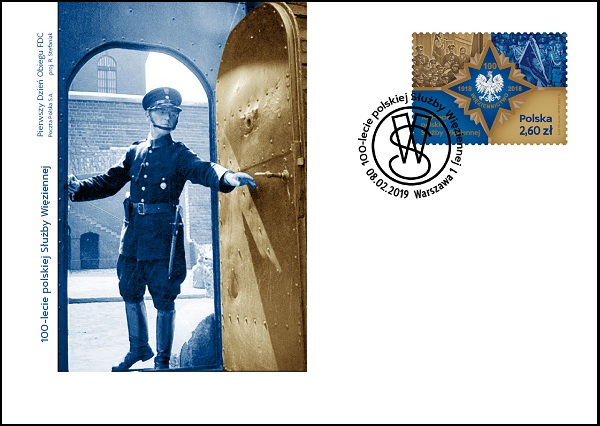

Sejm Ustawodawczy 1919 – 1922
www.nbp.pl
Narodowy Bank Polski jest centralnym bankiem państwa odpowiadającym za politykę pieniężną i stabilność cen. Jego funkcje określa Konstytucja Rzeczypospolitej Polskiej i ustawa o NBP. NBP ma wyłączne prawo emisji pieniądza. Jako bank centralny nie prowadzi rachunków bankowych obywateli, nie przyjmuje od nich lokat, nie udziela kredytów. Prowadzi natomiast obsługę budżetu państwa, a także podmiotów sektora finansów publicznych. Gromadzi rezerwy walutowe państwa i zarządza nimi. Pełni funkcję banku banków, tworząc warunki do działania systemu bankowego. Jest również jednym z najważniejszych ośrodków naukowo-analitycznych w dziedzinie ekonomii i rynków finansowych. 8 lutego 2019 roku Narodowy Bank Polski wprowadził do obiegu srebrną monetę o nominale 10 zł „Sejm Ustawodawczy 1919–1922″.
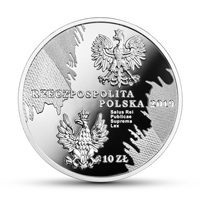
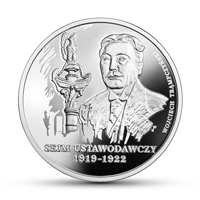
Nominał 10 zł … metal: Ag 925/1000; stempel: lustrzany;
średnica: 32,00 mm; masa: 14,14 g; brzeg (bok): gładki;
nakład: do 15 000 szt.; Projektant: Urszula Walerzak; Emitent: NBP;
Na zlecenie NBP monety wyprodukowała Mennica Polska S.A.
10 lutego 1919 r. po raz pierwszy w niepodległej Polsce zebrał się Sejm. Przemawiający z tej okazji Naczelnik Państwa Józef Piłsudski stwierdził: „W tej godzinie wielkiego serc polskich bicia czuję się szczęśliwym, że przypadł mi zaszczyt otwierać Sejm polski, który znowu będzie domu swego ojczystego jedynym panem i gospodarzem”. Liczba posłów zmieniała się kilka razy, co wynikało z kształtowania się granic i przeprowadzania dodatkowych wyborów na niektórych ziemiach granicznych. Finalnie, w marcu 1922 r. w Sejmie zasiadło 432 posłów. Sejm Ustawodawczy odbył 342 posiedzenia, uchwalając 571 ustaw. Ostatnie posiedzenie odbyło się 27 listopada 1922 r. Dzieło Sejmu Ustawodawczego doprowadziło do scalenia ziem wchodzących wcześniej w skład państw zaborczych i stworzyło filary ustrojowe nowoczesnej demokracji. Ukoronowaniem jego prac było przyjęcie 17 marca 1921 r. Konstytucji, która wprowadzała egalitarny ustrój republiki demokratycznej o parlamentarno-gabinetowym systemie rządów. Odwoływała się do monteskiuszowskiej koncepcji trójpodziału władz. Władzę zwierzchnią przyznawała narodowi. Na rewersie monety, upamiętniającej 100. rocznicę powołania Sejmu Ustawodawczego, przedstawiono portret Wojciecha Trąmpczyńskiego (1860–1953) oraz głowicę jego laski marszałkowskiej. Trąmpczyński był prawnikiem, działaczem Narodowej Demokracji. W okresie zaborów w pruskim Landtagu i niemieckim Reichstagu, dzięki doskonałej znajomości języka i prawa niemieckiego, zasłynął z rzeczowej krytyki antypolskiej polityki rządu. Był członkiem Naczelnej Rady Ludowej w Poznaniu. Został wybrany na marszałka Sejmu Ustawodawczego. Następnie, w latach 1922–1927 pełnił funkcję marszałka Senatu, a później w latach 1928–1935 zasiadał w ławach poselskich.
Portret Trąmpczyńskiego jest wzorowany na autolitografii Stanisława Lentza – malarza, portrecisty, ilustratora, profesora warszawskiej Szkoły Sztuk Pięknych. Wizerunek pochodzi z teki „Sejm Ustawodawczy Rzeczypospolitej Polskiej w portretach”, wydanej w 1919 r. Uwiecznioną na monecie laskę wręczono Wojciechowi Trąmpczyńskiemu z okazji imienin, 23 kwietnia 1920 r. Ufundowali ją z własnej inicjatywy posłowie. Laskę projektował Józef Teofil Smoliński – malarz, badacz sztuki, a wykonała ją warszawska firma Grzegorza i Feliksa Łopieńskich. Na głowicy laski (wzburzone fale morskie) unosi się jednomasztowy korab z żaglem i linami masztowymi (symbol państwa). Zamiast bocianiego gniazda umieszczono wieniec dębowy (alegoria zwycięstwa), na którym spoczywa orzeł w koronie z rozpostartymi skrzydłami (Orzeł Biały).
Laska marszałkowska była symbolem godności marszałka Sejmu i używano jej przy okazji otwarcia i zamknięcia sesji. Trzykrotne stuknięcie laską symbolizowało trzy stany sejmujące dawnej Rzeczypospolitej: króla, Senat i Izbę Poselską. Laska marszałka Wojciecha Trąmpczyńskiego jest na stałe eksponowana w Sejmie. Na awersie monety wprowadzono – podkreślając ciągłość tradycji parlamentarnych – godła II i III Rzeczypospolitej na tle polskiej flagi oraz napis Salus rei publicae suprema lex (Dobro Republiki Najwyższym Prawem). Dewiza, przypisywana Cyceronowi lub Salustiuszowi, była maksymą Sejmu II Rzeczypospolitej. Łacińską sentencję umieszczono nad stołem prezydialnym w Sali Posiedzeń Sejmu w 1919 r. Pojawiła się także na medalu „Otwarcie Sejmu Ustawodawczego” (aut. Jan Raszka, dat. 1919), oraz na medalu „Rocznica uchwalenia Konstytucji Marcowej, 1922″ (aut. Feliks Łopieński, dat. 1922). Informacja: Błażej Popławski.

Legislative Sejm of 1919 – 1922
www.nbp.pl
Narodowy Bank Polski is the central bank of the State, responsible for its monetary policy and price stability. The Bank’s functions are described in the Constitution of the Republic of Poland and the Act on NBP. NBP holds the exclusive right to issue the currency of the Republic of Poland. As the central bank, it does not provide accounts for the general public, accept deposits from or extend loans to individuals. It acts as a banker to the State budget and public sector entities. NBP also holds and manages the foreign exchange reserves of the State. Finally, it functions as a banker to banks, creating conditions for the operation of the Polish banking system. Narodowy Bank Polski is one of the most important research and analytical centres in the fields of economics and financial markets. On 8 February 2019, Narodowy Bank Polski issued into circulation a silver coin “The Legislative Sejm 1919–1922” with a face value of 10 złoty.


Face value: 10 zł … Metal: Ag 925/1000 Finish: proof Diameter: 32.00 mm;
Weight: 14.14 g; Edge (side): plain; Mintage: up to 15,000 pcs;
Designer: Urszula Walerzak Issuer: NBP; The coins, commissioned by NBP,
were struck by Mennica Polska S.A.
10 February 1919 marks the first session of the Sejm after Poland regained independence. The Chief of State, Józef Piłsudski, in his speech delivered on this occasion, said: “At this hour, as the hearts of Poles are pounding, I feel happy to have the privilege of opening the Polish Sejm, which will now become the sole master and host of its home country again.” The number of deputies changed several times as a result of the redrawing of Polish borders and the organization of bye-elections in some frontier areas. Ultimately, in March 1922, the Sejm consisted of 432 deputies. The Legislative Sejm held 342 sessions during which it passed 571 acts. The last session was held on 27 November 1922. The work of the Legislative Sejm led to the integration of the previously partitioned lands and to the formation of the structural pillars of modern democracy. The crowning of its work was the adoption, on 17 March 1921, of the Constitution, which established an egalitarian system of a democratic republic with a cabinet parliamentary mode of government. It was based on Montesquieu’s concept of tripartite separation of powers. It conferred the superior authority on the people.
The reverse of the coin commemorating the 100th anniversary of the establishment of the Legislative Sejm features the portrait of Wojciech Trąmpczyński (1860- 1953) and the head of his Marshal’s staff. Wojciech Trąmpczyński was a lawyer and an activist of the National Democracy. In the period following the partitions of Poland, thanks to his excellent command of the German language and law, he became famous for his matter-of-fact criticism of the anti-Polish politics of the government in the Prussian Landtag and German Reichstag. He was a member of the Supreme People’s Council in Poznań. He was elected Marshal of the Legislative Sejm. Then, in 1922-1927, he served as Marshal of the Senate, and between 1928-1935, he sat in the Sejm. The portrait of Wojciech Trąmpczyński is modelled on an autolithograph by Stanisław Lentz – a painter, portraitist, illustrator, and professor of the Warsaw School of Fine Arts. The image comes from the portfolio “The Legislative Sejm of the Republic of Poland in Portraits”, published in 1919. The staff shown on the coin was handed to Wojciech Trąmpczyński on his name day, 23 April 1920. It was funded by deputies on their own initiative. The staff was designed by Józef Teofil Smoliński – a painter and art researcher, and it was made by the Warsaw firm of Grzegorz and Feliks Łopieński.
The head of the staff (stormy sea waves) carries a single-masted boat with a sail and shrouds (the symbol of the state). In place of the crow’s nest there is an oak wreath (symbolizing victory) on top of which an eagle is perched with a crown and outstretched wings (the White Eagle). The Marshal’s staff symbolized the dignity of the Sejm Marshal and it was used at the opening and closing of each session. Striking the staff three times against the floor symbolized the three estates of the former Republic of Poland: the King, the Senate, and the House of Deputies (the lower chamber). The staff of Marshal Wojciech Trąmpczyński is on permanent exhibition at the Sejm. The obverse of the coin features – to emphasize the continuity of parliamentary traditions – the emblems of the Second and Third Republic of Poland against the Polish flag, and the inscription Salus rei publicae suprema lex (the Welfare of the Republic shall be the Supreme Law). The motto, attributed to Cicero or Sallust, was the maxim of the Sejm of the Second Republic of Poland. The Latin proverb was placed above the presidium table in the Session Room of the Sejm in 1919. It also appeared on the medals – “The Opening of the Legislative Sejm” (author: Jan Raszka, dated 1919) and “TheAnniversary of the Adoption of the March Constitution, 1922” (author: Feliks Łopieński, dated 1922). Info: Błażej Popławski.


The Group of Seven
www.canadapost.ca https://postagestampguide.com
The Group of Seven, a school of landscape painters, embodied in their early 20th century work the first distinctly national movement in Canadian art. The artists were J.E.H. MacDonald, A.Y. Jackson, Artur Lismer, Lawren Harris, F.H. Varley, Franklin Carmichael, and Franz Johnston. Another influential member, Tom Thomson, died in 1917. Although national in outlook and emphasis, paintings by the Group of Seven which appear on the stamps of Canada show European influences. “The Isles of Spruce” by Artur Lismer, recalls Van Gogh’s use of line and colour. “The Jack Pine” by Tom Thomson is an elemental view of nature. “Bylot Island” by Lawren Harris, and “The Solemn Land” by J.E.H. MacDonald incorporate the sweeping lines and stark patterns of ice and snow common to these artists.
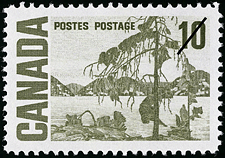
Denomination: 10¢ … Date of Issue: February 8, 1967;
Perforation or Dimension: 12;
Printer: Canadian Bank Note Company, Limited.
The date of this stamp is hidden at the base of the mountain on the left-hand side of the stamp. Design for the 10¢ issue is a central portion of a work done by Tom Thomson, titled “The Jack Pine”. Creators: Picture engraved by Allan Alexander Carswell. Lettering engraved by Gordon Mash. Original Artwork: Thomas John Thomson, “The Jack Pine”, 1916-1917 National Gallery of Canada, Ottawa, Ontario.
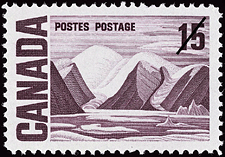
Denomination: 15¢ … Date of Issue: February 8, 1967;
Perforation or Dimension: 12;
Printer: Canadian Bank Note Company, Limited.
The hidden date for this stamp can be found next to the floating iceberg. Design for the 15¢ issue is a central portion of a work done by Lawren Harris titled “Greenland Mountains”. Creators: Based on a painting by Lawren Stewart Harris. Picture engraved by Allan Alexander Carswell. Lettering engraved by Gordon Mash. Original Artwork: Lawren Stewart Harris, “Greenland Mountains”, circa 1930 National Gallery of Canada, Ottawa, Ontario.
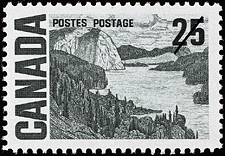
Denomination: 25¢ … Date of Issue: February 8, 1967;
Perforation or Dimension: 12;
Printer: Canadian Bank Note Company, Limited.
The date for this stamp is hidden in the peninsula that is jutting into the lake. Design for the 25¢ issue is a central portion of a work by J.E.H. MacDonald, titled “The Solemn Land”. Creators: Picture engraved by Allan Alexander Carswell. Lettering engraved by Gordon Mash. Original Artwork: James Edward Hervey MacDonald, “The Solemn Land”, 1921 National Gallery of Canada, Ottawa, Ontario.

Denomination: 6¢ … Date of Issue: September 18, 1970;
Quantity: 36,203,000; Perforation or Dimension: 11;
Printer: Ashton-Potter Limited.
Historical Notice: … The passage of time has resulted in an enthusiastic acceptance and appreciation of the Canadian identity portrayed so vividly in paintings by the Group of Seven which, since its founding fifty years ago, has influenced if not dominated Canadian landscaping paintings. The Group of Seven’s formative years could be best be described as 1910 to 1913, in an era of expanding trade and increasing immigration. However, the coming of World War I, in 1914, temporarily dimmed the “national movement” in the art which was then taking place. It was not until 1919, with war a thing of the past, that members of the yet to be named group resumed interpreting Canada’s rugged wilderness terrain while living in the equally rugged environment of a railway freight car. Their style eventually brought distinction to Canada and to them undying fame. Today, their works, so well known, could almost be regarded as national symbols. In the years immediately preceding 1920, the same group of kindred spirits became known as the Algonquin school because of the frequency with which they painted in Ontario’s wilderness Algonquin Park. And it was in Algonquin Park, too, that tragedy struck with the 1917 canoe accident drowning of Tom Thomson, a gifted artist who painted with members of the eventual Group of Seven. Thomson’s paintings created during a brief six years career are frequently associated with those of the Group formed three years after his death.
Original members of the Group of Seven in 1920 were Franklin Carmicheal, Lawren Harris, A.Y. Jackson, Frank Johnston, Arthur Lismer, J.E.H. MacDonald and F.H. Varley. Johnston’s withdrawal in 1922 reduced the membership to six until Alfred Casson joined in 1926. Two more, one being Edwin H. Holgate in 1931 and the other Lemoine FitzGerald in 1932, joined the ranks. There was little if any organized structure but it is recognized that the Group existed in a very real sense until it evolved into another and broader body, the Canadian Group of Painters, in 1933. Results achieved by the Group of Seven, with its concentration on design and colour, were far removed from the impressionism of the day. As described by Canada’s National Gallery in Ottawa: “… they brought to the Canadian landscape the buoyant post-impressionism of Van Gogh and they painted Canada as nobody had ever thought of painting it before.
The wild colours of a Canadian autumn; the solitary lakes of northland; the monolithic islands of Lake Superior; the glacier-tortured landscape of the Laurentian Shield; the grim exhaustion of a hillside emerging from four months of winter snow – this was Canada as it is, a land like none other, and Canadians abruptly recognized it as their own.” Although paintings created by the Group of Seven now occupy an extremely high place in Canada’s artistic heritage, public acceptance was far from unanimous in the Group’s early days. A derogatory “hot mush” was frequently resorted to in describing the fresh, bold concepts used in interpreting the rugged landscapes peculiar to Canada. In some instances, public concern was reflected in statements that the distribution of such paintings would render a disservice by discouraging immigration to our shores. (40-IV-19)

From Far and Wide
www.canadapost.ca
Share the stunning beauty of some of Canada’s most spectacular scenery with this coil of 100 PermanentTM domestic stamps, part of the second issue in our multi-year From Far and Wide series. Each of the five unique stamps on the coil features an eye-catching photograph of a scenic Canadian spot. Explore the rugged trails and ragged mountains of Yukon’s Tombstone Territorial Park. Feel the spray of roaring waters cascading over Athabasca Falls in Alberta’s Jasper National Park. Touch the top of the world from the isolated Arctic wilderness of Nunavut’s Quttinirpaaq National Park, pop by picturesque Mahone Bay, Nova Scotia, to admire its trio of heritage churches and gaze in wonder at the colour-changing waters of Manitoba’s Little Limestone Lake.

Stamp value: 5 x PermanentTM (domestic rate); Issue date: January 14, 2019;
Quantity produced: Continuous printing; Dimensions: 24 mm x 20 mm;
Stamp Designer: Stéphane Huot.
Share the rugged beauty of one of Canada’s must-see places with this coil of 50 US-rate stamps featuring Ontario’s Algonquin Provincial Park. This is one of nine definitives in the second issue of From Far and Wide, a multi-year series featuring some of Canada’s most beautiful landscapes. Ontario’s oldest provincial park, Algonquin was established in 1893 to protect the headwaters of five major rivers, preserve native forests and wildlife, and provide recreational opportunities. Now roughly double its original size, Algonquin Park protects 7,630 square kilometres of the quintessentially Canadian landscape, including rocky hills, mixed forests, and more than 2,000 lakes.
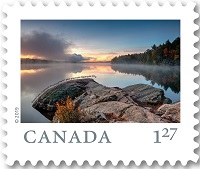
Stamp value: $1.27 (U.S. rate); Issue date: January 14, 2019;
Quantity produced: Continuous printing; Dimensions: 24 mm x 20 mm;
Stamp Designer: Stéphane Huot.
Share the beauty of icebergs with this coil of 50 international-rate stamps featuring a massive iceberg floating past the coast of Newfoundland and Labrador. This is one of nine definitives in the second issue of From Far and Wide, a multi-year series featuring some of Canada’s most beautiful landscapes. Each spring and early summer, the spectacular sight of icebergs drifting down from the Arctic draws crowds to viewpoints overlooking the offshore route known as Iceberg Alley. The photograph on this stamp was taken in Ferryland on the Avalon Peninsula, one of many coastal communities where tourists and locals gather to gaze at these frozen giants as they float south toward the Grand Banks.
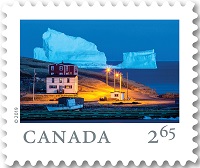
Stamp value: $2.65 international rate; Issue date: January 14, 2019;
Quantity produced: Continuous printing; Dimensions: 24 mm x 20 mm;
Stamp Designer: Stéphane Huot.
Explore ancient ocean-sculpted monoliths with this coil of 50 oversized-rate stamps featuring the unique limestone islands of Quebec’s Mingan Archipelago National Park Reserve. This is one of nine definitive stamps in the second issue of From Far and Wide, a multi-year series featuring some of Canada’s most beautiful landscapes. These distinctive formations depicted on this stamp are the result of an ancient limestone plateau that rose up through continental shifting and was carved by the waters of the Gulf of St. Lawrence. The archipelago’s more-than 1,000 islands and islets feature monoliths, caves, archways, and grottoes. The area is home to rare plants, several species of marine birds, seals, whales, and other animals.
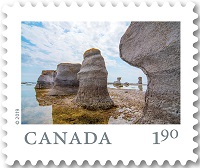
Stamp value: $1.90 (oversized rate; Issue date: January 14, 2019;
Quantity produced: Continuous printing; Dimensions: 24 mm x 20 mm;
Stamp Designer: Stéphane Huot.
From Far and Wide: Souvenir Sheet of 9 stamps … Explore some of Canada’s most beautiful spots with this collectible souvenir sheet featuring all nine stamps from the second issue of From Far and Wide, a multi-year series celebrating stunning Canadian scenery and must-see destinations. The souvenir sheet features five PermanentTM domestic stamps, a $1.05 domestic-rate stamp, a U.S.-rate stamp, an oversized-rate stamp, and an international-rate stamp. The scenes depicted on the five PermanentTM domestic stamps include the ragged mountains of Yukon’s Tombstone Territorial Park, the roaring waters of Alberta’s Athabasca Falls, the isolated Arctic wilderness of Nunavut’s Quttinirpaaq National Park, the picturesque heritage churches of Mahone Bay, Nova Scotia, and the colour-changing waters of Manitoba’s Little Limestone Lake. The $1.05 domestic-rate stamp shows Saskatchewan’s Castle Butte, the U.S.-rate stamp depicts Smoke Lake in Ontario’s Algonquin Provincial Park and the oversized-rate stamp features the unique limestone islands of Quebec’s Mingan Archipelago National Park Reserve. On the international-rate stamp, a massive iceberg drifts past a stretch of coast in Newfoundland and Labrador known as Iceberg Alley.
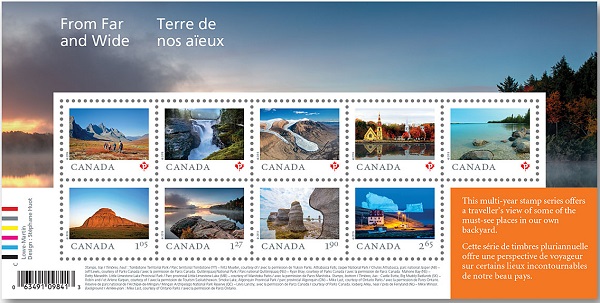
Stamp value: 5 x PermanentTM, 1 x $1.05, 1 x $1.27, 1 x $1.90, 1 x $2.65;
Issue date: January 14, 2019; Quantity produced: 80,000;
Dimensions: 150 mm x 75 mm; Stamp Designer: Stéphane Huot.
From Far and Wide: Souvenir Sheet Official First Day Cover … Marvel at the beauty of some of Canada’s most stunning scenery with this souvenir sheet Official First Day Cover. This colourful collectible includes all nine stamps from the second issue of From Far and Wide, a multi-year series celebrating must-see spots from coast to coast to coast. The souvenir sheet Official First Day cover features five PermanentTM domestic stamps, a $1.05 domestic-rate stamp, a US-rate stamp, an oversized-rate stamp, and an international-rate stamp. The scenes depicted on the PermanentTM domestic stamps include the ragged mountains of Yukon’s Tombstone Territorial Park, the roaring waters of Alberta’s Athabasca Falls, the isolated Arctic wilderness of Nunavut’s Quttinirpaaq National Park, the picturesque heritage churches of Mahone Bay, Nova Scotia, and the colour-changing waters of Manitoba’s Little Limestone Lake. The $1.05 domestic-rate stamp shows Saskatchewan’s Castle Butte, the U.S.-rate stamp depicts Smoke Lake in Ontario’s Algonquin Provincial Park and the oversized-rate stamp features the unique limestone islands of Quebec’s Mingan Archipelago National Park Reserve. On the international-rate stamp, a massive iceberg drifts past the stretch of coast in Newfoundland and Labrador known as Iceberg Alley. The stamps are cancelled in Mahone Bay, Nova Scotia, with pictorial cancellation of church steeples.
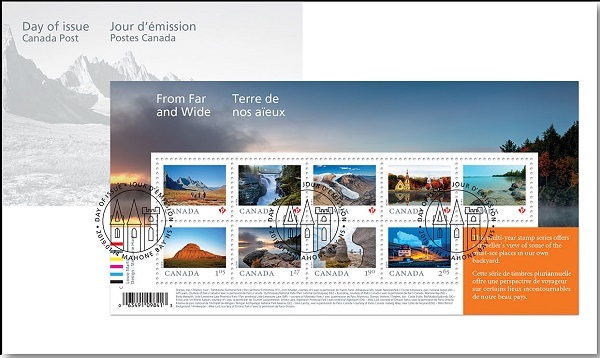
Stamp value: 5 x PermanentTM, 1 x $1.05, 1 x $1.27, 1 x $1.90, 1 x $2.65;
Issue date: January 14, 2019; Quantity produced: 7,000;
Dimensions: 190 mm x 112 mm; Stamp Designer: Stéphane Huot.
Cancellation site: Mahone Bay NS.

2019 … $20 Pure Silver Coin – Norse Gods: Thor
www.canadapost.ca www.mint.ca
Step into the realm of gods and giants … In the time of Canada’s Viking Age (c. 1000), quick-tempered Thor was one of the most admired figures of Norse faith and lore. It is from him that we get the word “Thursday” (Thor’s Day). His legendary strength and fearlessness are evident on the coin’s reverse, where the apocalyptic battle scene is enhanced with selective gold plating. First of three coins dedicated to powerful Norse gods. The son of Odin and Jord, Thor is the ultimate Norse warrior. His courage and brawn make him the ideal defender of Asgard, one of the nine worlds. Norse art-inspired elements and a historic artifact frame the obverse and reverse. The son of Odin and Jord, Thor is the ultimate Norse warrior. His courage and brawn make him the ideal defender of Asgard, one of the nine worlds.

Face value: 20 dollars … Composition: 99.99% pure silver;
Finish: Proof with gold plating; Weight: 31.39 g;
Diameter: 38 mm; Mintage: 3,500; Artist: Alexandra Lefort.
Norse mythology has influenced the way we tell stories and give rise to some everyday words. Its tales of gods and giants represented tradition to the Vikings of Vinland, and folklore to Scandinavian settlers in Canada. Now, we’re combining history and myth in a limited series dedicated to the Norse gods, and it begins with the hammer-wielding thunder god: Thor. In the time of Canada’s Viking Age (c. 1000), quick-tempered Thor was one of the most admired figures of Norse faith and lore, and it is from him that we get the word “Thursday” (Thor’s Day). His strength and fearlessness are evident on your coin, where the apocalyptic battle scene is enhanced with selective gold plating.
Design: Designed by Alexandra Lefort, your coin depicts the battle between Thor and Jörmungandr at Ragnarök, an end-of-days event in Norse mythology. Clad in the finest clothing and armour of the Viking era, the Norse god of thunder stands with his hammer raised, ready to strike the coiled serpent. Selective gold plating highlights Thor’s hammer (Mjöllnir), iron gloves (Járngreipr) and belt (Megingjörð). A Norse art-inspired pattern lines the rim on the obverse and reverse. The gold-plated goat heads represent Tanngrisnir and Tanngnjóstr, who pull Thor’s chariot, while the gold-plated Mjöllnir is based on a 10th-century silver pendant. The obverse features the gold-plated effigy of Her Majesty Queen Elizabeth II by Susanna Blunt.
Did you know … * The son of Odin and Jord, Thor is the ultimate Norse warrior. His courage and brawn make him the ideal defender of Asgard, one of the nine worlds and home to Aesir gods Odin, Frigg, and many more. * Thor has three key possessions: Mjöllnir, a giant-slaying hammer; Járngreip, his iron gloves; and Megingjörð, a belt that doubles his physical strength. All three are gold-plated on the coin’s reverse. * Thor represents strength, but he is also the god of agriculture and fertility. * His arch-enemy is Jörmungandr, a giant sea serpent that wraps around Midgard (Earth). The middle child of Loki and Angrboða, Jörmungandr battles Thor during Ragnarök; the Norse thunder god kills Jörmungandr, but ultimately falls victim to the serpent’s venom after walking nine paces.

2019 … Pure Silver 2-Coin Set –
Royal Canadian Mint Coin Lore: Back to Concept
www.canadapost.ca www.mint.ca
Familiar but different: This two-coin set brings you unreleased versions of two classics. Back by popular demand! We dug deep into the archives to bring you early takes on two classic Canadian designs: Emanuel Hahn’s Voyageur dollar (1935) and “caribou” 25 cents (1937). These 2 oz.-sized images may look familiar, but they are new sculpts that are based solely on the artist’s preliminary sketches. Every laser-engraved guide and design variation is in keeping with Hahn’s hand-drawn vision. They offer a rare glimpse of the evolution of two numismatic works of art, from idea to coin to an icon.
In the tradition of the 2017 Forgotten 1927 Designs and 2018 Coins That Never Were sets, we’ve gone to the National Currency Collection – Bank of Canada to reveal the untold and unseen story of two beloved designs: Emanuel Hahn’s Voyageur dollar and the caribou-themed 25-cent coin. Includes a presentation booklet. Each set comes with a booklet featuring images of Hahn’s original art, which is preserved in the National Currency Collection – Bank of Canada. 21st century technology meets 20th century art. Hahn’s pencilled drawing guides are re-created using laser engraving technology on a flat field, where the lines are visible without dominating the art. A legacy. A legend. The pencil drawings that inspired these coins are part of Emanuel Hahn’s tremendous numismatic and artistic legacy.

Composition: 99.99% pure silver; Finish: Proof; Mintage: 1,750;
Weight: 62.69 g (each); Diameter: 50 mm (each);
Artist: Emanuel Hahn.
Back by popular demand! In the tradition of our successful 2017 Forgotten 1927 Designs and 2018 Coins That Never Were sets, we’ve gone back into the archives and dug deep to bring you more early coin concepts—and on a much bigger canvas. This set features an early take on two classic coin designs: Emanuel Hahn’s Voyageur dollar (1935) and “caribou” 25 cents (1937). The images may look familiar, but the all-new sculpts are based solely on the artist’s preliminary pencil sketches, which are preserved in the National Currency Collection – Bank of Canada.
Designs: The 25-cent coin re-creates a preliminary sketch of the iconic caribou design by artist Emanuel Hahn. The Big Dipper asterism appears behind the left-side profile of Rangifer tarandus, while the denomination “25 CENTS” is positioned between the caribou’s antlers. Laser engraving on flat mimics the artist’s hand-drawn guide lines. The reverse includes the word “CANADA” and updated date, “2019”. The obverse features the effigy of King George VI by T. H. Paget.
The $1 coin also features Emanuel Hahn’s early take on the Voyageur design that eventually appeared on Canada’s silver dollars (1935-1986). Beneath the aurora borealis, a voyageur and an Indigenous guide paddle a fur-laden canoe past wind-swept pines that rise up from a semi-circular island. Laser engraving on flat mimics the artist’s hand-drawn guide lines. The reverse includes the word “CANADA”, an updated date “2019” and the denomination, “DOLLAR”. The obverse features the effigy of King George VI by T. H. Paget.
Did you know … * The stars align differently on this version of the 25-cent coin… Emanuel Hahn’s early version of the caribou design included a slightly different-looking rack of antlers and the Big Dipper asterism in the background. The seven stars appear on preliminary sketches for the 5-cent and, later, the 25-cent coin (seen in this set). All but three stars were removed sometime in 1937; those three can still be seen in the legend, before and after the word “CANADA” and just before the year. * Text elements are different, too… The word “CENTS” appears as all caps on this early version of the 25-cent, which doesn’t include fur texture on the neck. And take a closer look at the canoe on this version of the dollar coin—the “HB” letters are positioned differently, while the insignia on the canoe is erased. The travellers are also missing distinctive pieces of clothing (a feather, a fur cap, and a handkerchief). * An earlier drawing reveals a Voyageur design that didn’t include the Northern Lights… At one time, a fleur-de-lis and a maple leaf were included in the legend; birds were seen in the sky and a forest appeared to rise up in the distant horizon. The design was revised to include the aurora borealis, which were represented by sharp vertical lines. On this version, the Northern Lights have a softer, more gradually etched appearance that is closer to the original art.



www.gtapa.org
The GTAPA is committed to promote and stimulate the art of philately
to all ages for fun, culture, education, and friendship.


Royal *2019* Royale
www.rpsc.org/royal2019
The West Toronto Stamp Club, Bramalea Stamp Club, and Canadian Stamp News are co-hosting Royal *2019* Royale. The June 21-23 convention will be held at the classy Hilton Mississauga on 6750 Mississauga Road. The next annual general meeting (AGM) of The Royal Philatelic Society of Canada (RPSC) will be held on the morning of June 22 during the society’s 91st convention in Mississauga, Ontario. The aim of the AGM, which will be held at the Hilton Mississauga/Meadowvale, is for members to receive and consider reports from executive members, directors and duty officers as well as the society’s financial statements as of Dec. 31. Members will also consider – and if approved, ratify, sanction and confirm – all by-laws, contracts, acts, and proceedings of The RPSC’s board of directors enacted since the last AGM. There will also be an election of seven directors. The 2019 election of director positions will be decided by secret ballots submitted by members of the society.




